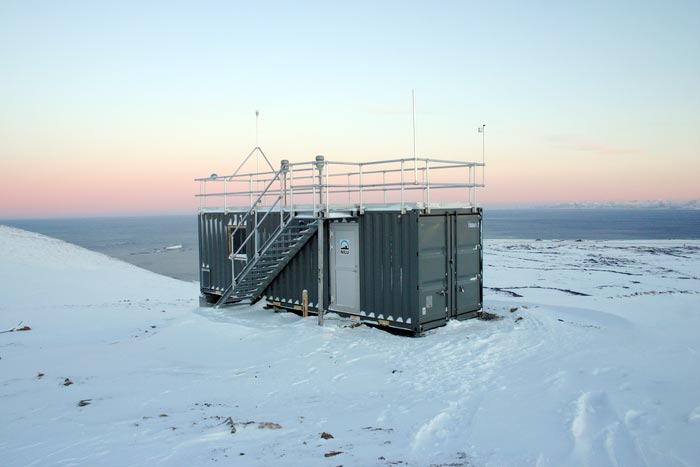Harmful boomerang: PFAS pollution in ocean comes back to land

The sampling station Andøya, Norway, in the winter.
Photo: NILU
Many of the per- and polyfluoroalkyl substances (PFAS) that end up in the ocean boomerang back to shore after they are re-emitted into air with the crashing of waves, according to a study by researchers at Stockholm University published today in Environmental Science & Technology. The findings suggest that this sea-to-air transport process is a significant contributor to PFAS air pollution in coastal areas.
“The common belief was that PFAS would eventually wash off into the oceans where they would stay to be diluted over the timescale of decades,” said Matthew Salter, a co-author of the study and researcher at the Department of Environmental Science, Stockholm University. “But it turns out that there’s a boomerang effect, and some of the toxic PFAS are re-emitted to air, transported long distances and then deposited back onto land.”
Air samples from Norway
Previous laboratory research by the team showed clear evidence that sea spray aerosol can be an important source of PFAS in the atmosphere. Now the new study provides field evidence that this is indeed true. From 2018 to 2020, the research team collected air samples from two coastal areas in Norway. They found that air concentrations of most the PFAS measured—particularly substances with long fluorinated carbon chains like the cancer-causing perfluorooctanoic acid (PFOA)—were strongly linked to markers of sea spray aerosol (sodium ions). The findings indicate that these PFAS are transported from seawater to marine air by sea spray aerosols, which constitute a significant source of PFAS air pollution to coastal communities.
“Luckily we were able to collaborate with the Norwegian Institute of Air Research who conducted the long-term air sampling for us,” said Bo Sha, PhD student at the Department of Environmental Science, Stockholm University and main author of the study. “Afterwards many months were spent in the lab analyzing the samples for PFAS and sea spray aerosol markers. The results are fascinating but at the same time concerning,” added Bo Sha.
PFAS are harmful to health and the environment
PFAS is a collective name for per- and polyfluorinated alkyl substances or highly fluorinated substances that have a similar chemical structure. All PFAS are either extremely persistent in the environment or break down into extremely persistent PFAS, which has earned them the nickname “forever chemicals.”
PFAS have been associated with a wide range of serious health harms, including cancer, learning and behavioral problems in children, infertility and pregnancy complications, increased cholesterol, and immune system problems.
“It is possible that atmospherically deposited PFAS could contaminate coastal drinking water sources for the foreseeable future,” said Professor Ian Cousins, another co-author of the study, at the Department of Environmental Science, Stockholm University. “Our study gives a new dimension to the meaning of the term forever chemicals. Even the PFAS we thought would be lost to the sea boomerang back for us to be exposed all over again,” said Cousins.
The research has been funded by the Swedish Research Council (Reg. no.: 2016-04131) and FORMAS, a government research council for sustainable development (Reg. no.: 2016-00644).
More information
The article “Sea spray aerosol (SSA) as a source of perfluoroalkyl acids (PFAAs) to the atmosphere: field evidence from long-term air monitoring” is published in the scientific journal Environmental Science & Technology.
https://doi.org/10.1021/acs.est.1c04277
Available for interviews:
Mr. Bo Sha, lead author (for interviews in English), Department of Environmental Science, Stockholm University, Bo.Sha@aces.su.se, +46 (0)72 904 1942.
Dr. Matthew Salter (for interviews in English), Department of Environmental Science, Stockholm University, Matthew.Salter@aces.su.se, +46 (0) 8 674 7222.
Dr. Jana Johansson (for interviews in Swedish or English), Department of Environmental Science, Stockholm University, jana.johansson@aces.su.se, +46 (0)72 004 1712.
Prof. Ian Cousins (for interviews in Swedish or English), Department of Environmental Science, Stockholm University, Ian.Cousins@aces.su.se, +46 (0)72 148 9232.
Journal: Environmental Science & Technology
DOI: 10.1021/acs.est.1c04277
Method of Research: Experimental study
Subject of Research: Not applicable
Article Title: “Sea spray aerosol (SSA) as a source of perfluoroalkyl acids (PFAAs) to the atmosphere: field evidence from long-term air monitoring”
Article Publication Date: 15-Dec-2021
Media Contact
Annika Hallman
Stockholm University
annika.hallman@su.se
Office: 46-870-664-2264
All latest news from the category: Ecology, The Environment and Conservation
This complex theme deals primarily with interactions between organisms and the environmental factors that impact them, but to a greater extent between individual inanimate environmental factors.
innovations-report offers informative reports and articles on topics such as climate protection, landscape conservation, ecological systems, wildlife and nature parks and ecosystem efficiency and balance.
Newest articles

Innovative 3D printed scaffolds offer new hope for bone healing
Researchers at the Institute for Bioengineering of Catalonia have developed novel 3D printed PLA-CaP scaffolds that promote blood vessel formation, ensuring better healing and regeneration of bone tissue. Bone is…

The surprising role of gut infection in Alzheimer’s disease
ASU- and Banner Alzheimer’s Institute-led study implicates link between a common virus and the disease, which travels from the gut to the brain and may be a target for antiviral…

Molecular gardening: New enzymes discovered for protein modification pruning
How deubiquitinases USP53 and USP54 cleave long polyubiquitin chains and how the former is linked to liver disease in children. Deubiquitinases (DUBs) are enzymes used by cells to trim protein…



